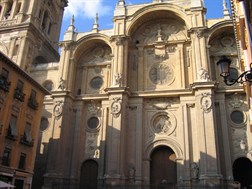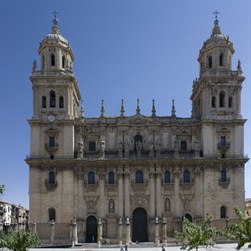Granada and Jaén
 With the surrender of Granada in 1492 the centuries-old process of Reconquista of the Iberian Peninsula came to an end. From that date, the Andalusian city experienced the same changes that already been undergone by other Spanish cities before, namely the adaptation of places, symbols and ways of life and the Arab mentality to the tastes of the new Christian rulers. A few years after the surrender, the project of building a great cathedral was launched. Enrique Egas was charged with the direction of the work, although it was Diego de Siloé, beginning in 1529, who lead the construction work. In the seventeenth century, the construction of the new main façade was entrusted to the architect Alonso CanoAlonso Cano (1601-1667), among the greatest Spanish artists of the seventeenth century, was born and died in Granada. He was also active at court, where he was singled out by his friend Velázquez. Accused of murdering his wife in 1644, he became a monk, taking refuge in Valencia. Thanks to the protection of Philip IV, he returned to Madrid and assumed the post of superintendent of the Cathedral of Granada. He worked at the cathedral of his native city until the last days of his life, and was buried in it., gave a magnificent Baroque appearance to Granada’s cathedral. Cano’s project, however, was suddenly interrupted by the death of the architect, in 1667. The absence of its creator, combined with harsh economic problems, prevented the cathedral from reaching the magnificence which had been initially planned, as is demonstrated by the failure of the two towers to rise to the 81 metres provided for in the original design.
With the surrender of Granada in 1492 the centuries-old process of Reconquista of the Iberian Peninsula came to an end. From that date, the Andalusian city experienced the same changes that already been undergone by other Spanish cities before, namely the adaptation of places, symbols and ways of life and the Arab mentality to the tastes of the new Christian rulers. A few years after the surrender, the project of building a great cathedral was launched. Enrique Egas was charged with the direction of the work, although it was Diego de Siloé, beginning in 1529, who lead the construction work. In the seventeenth century, the construction of the new main façade was entrusted to the architect Alonso CanoAlonso Cano (1601-1667), among the greatest Spanish artists of the seventeenth century, was born and died in Granada. He was also active at court, where he was singled out by his friend Velázquez. Accused of murdering his wife in 1644, he became a monk, taking refuge in Valencia. Thanks to the protection of Philip IV, he returned to Madrid and assumed the post of superintendent of the Cathedral of Granada. He worked at the cathedral of his native city until the last days of his life, and was buried in it., gave a magnificent Baroque appearance to Granada’s cathedral. Cano’s project, however, was suddenly interrupted by the death of the architect, in 1667. The absence of its creator, combined with harsh economic problems, prevented the cathedral from reaching the magnificence which had been initially planned, as is demonstrated by the failure of the two towers to rise to the 81 metres provided for in the original design.
 Within the same region of Andalusia, another beautiful Baroque façade grafted on building of a different style and era is the cathedral of JaénJaén is one of the oldest cities in Spain. Reconquered by the Christians in the thirteenth century, it underwent the process common to many other cities in the Iberian peninsula, namely the transformation from an Arab city to a Christian one. In the Early Modern Period, Jaén never recovered its former glory. It experienced a period of severe crisis, like many other Castilian cities, in the seventeenth century, crushed by taxes and by the necessities of war of the Spanish monarchy.. Dedicated to the Asunción de la Virgen (the Assumption of the Virgin), the church was built on an ancient mosque at the time of Ferdinand III the Saint (XIII century). In the fifteenth century, they began to build the Gothic sanctuary to preserve the cloth of the Holy Face which, according to tradition, was used by Veronica to wipe the face of Christ. The work carried out during the sixteenth century, primarily the result of the work of Andrés de Vandelvira, turned the cathedral into one of the most important examples of Renaissance art in Spain. The damage caused by the great earthquake of 1755 caused further renovation of the complex. The Baroque façade was designed by Eufrasio López de RojasEufrasio López de Rojas (1628-1684) was a Spanish architect, best known for the façade of the Cathedral of Jaén. The chief overseer of the work on the cathedral, he had previously held the same post at the Cathedral of Granada. He was buried in the convent of the Discalced Carmelites in Jaén..
Within the same region of Andalusia, another beautiful Baroque façade grafted on building of a different style and era is the cathedral of JaénJaén is one of the oldest cities in Spain. Reconquered by the Christians in the thirteenth century, it underwent the process common to many other cities in the Iberian peninsula, namely the transformation from an Arab city to a Christian one. In the Early Modern Period, Jaén never recovered its former glory. It experienced a period of severe crisis, like many other Castilian cities, in the seventeenth century, crushed by taxes and by the necessities of war of the Spanish monarchy.. Dedicated to the Asunción de la Virgen (the Assumption of the Virgin), the church was built on an ancient mosque at the time of Ferdinand III the Saint (XIII century). In the fifteenth century, they began to build the Gothic sanctuary to preserve the cloth of the Holy Face which, according to tradition, was used by Veronica to wipe the face of Christ. The work carried out during the sixteenth century, primarily the result of the work of Andrés de Vandelvira, turned the cathedral into one of the most important examples of Renaissance art in Spain. The damage caused by the great earthquake of 1755 caused further renovation of the complex. The Baroque façade was designed by Eufrasio López de RojasEufrasio López de Rojas (1628-1684) was a Spanish architect, best known for the façade of the Cathedral of Jaén. The chief overseer of the work on the cathedral, he had previously held the same post at the Cathedral of Granada. He was buried in the convent of the Discalced Carmelites in Jaén..
